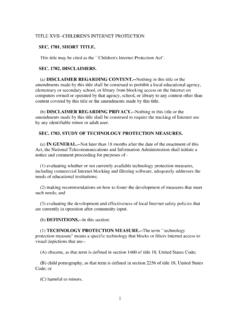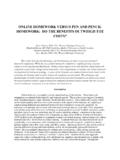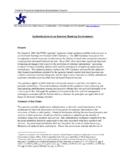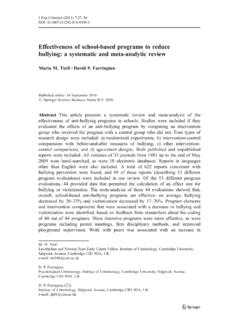Transcription of RESEARCH REPORT 138 - HSE: Information about …
1 HSE Health & Safety Executive Best practice in rehabilitating employees following absence due to work-related stress Prepared by The Institute for Employment Studies for the Health and Safety Executive 2003 RESEARCH REPORT 138 HSE Health & Safety Executive Best practice in rehabilitating employees following absence due to work-related stress Dr L Thomson, F Neathey, Dr J Rick The Institute for Employment Studies Mantell Building Falmer Brighton BN1 9RF The emphasis of this RESEARCH project is on identifying specific examples of best practice following absence due to stress-related illness, and various factors which influence its effectiveness. This will provide employers not only with Information on different types of practices, and the evidence of their effectiveness, but also any specific elements that contribute to this effectiveness.
2 Secondly, the RESEARCH aims to highlight any costs and benefits of rehabilitation practices that are identified. It will also consider the historical development of rehabilitation practices within the case study organisations, and describe the key factors influencing the development of procedures. It is envisaged that this type of Information will be important in encouraging other employers to develop their own rehabilitation practices. This REPORT and the work it describes were funded by the Health and Safety Executive (HSE). Its contents, including any opinions and/or conclusions expressed, are those of the authors alone and do not necessarily reflect HSE policy. HSE BOOKS Crown copyright 2003 First published 2003 ISBN 0 7176 2715 2 All rights reserved.
3 No part of this publication may be reproduced, stored in a retrieval system, or transmitted in any form or by any means (electronic, mechanical, photocopying, recording or otherwise) without the prior written permission of the copyright owner. Applications for reproduction should be made in writing to: Licensing Division, Her Majesty's Stationery Office, St Clements House, 2-16 Colegate, Norwich NR3 1BQ or by e-mail to ii The Institute for Employment Studies The Institute for Employment Studies is an independent, apolitical, international centre of RESEARCH and consultancy in human resource issues. It works closely with employers in the manufacturing, service and public sectors, government departments, agencies, professional and employee bodies, and foundations.
4 For over 30 years the Institute has been a focus of knowledge and practical experience in employment and training policy, the operation of labour markets and human resource planning and development. IES is a not-for-profit organisation which has a multidisciplinary staff of over 60. IES expertise is available to all organisations through RESEARCH , consultancy, publications and the Internet. IES aims to help bring about sustainable improvements in employment policy and human resource management. IES achieves this by increasing the understanding and improving the practice of key decision makers in policy bodies and employing organisations. iii Acknowledgements This project was conducted jointly by the Institute for Employment Studies (IES) and Industrial Relations Services RESEARCH (IRSR).
5 A large team of researchers was involved in the collection of the data, all of whom we wish to thank for their hard work: Katherine Mann, Jo Regan, Siobh n O Regan and Marije Van Gent from IES; and Debbie Sanders from IRSR. In addition to the RESEARCH team we drew on the expertise of a number of external advisers who specialise in rehabilitation and return to work: Rosie Dickson from The Rehab Group, Fiona Jones at the University of Leeds; and John Ballard, Editor of Occupational Health Review. We also obtained the views of a number of other experts in the field. These are listed in the main body of the REPORT . Our thanks go to all those concerned. We also wish to thank Emma Hart, Andy Davidson and Charlie Bass at IES for their work in preparing the final draft of the REPORT .
6 Louise Thomson at IES designed and managed this project from it s inception last year to near it s delivery this year, at which point she went on maternity leave to deal with a delivery of her own. As a result the REPORT was completed by her co-authors, so any omissions or errors are ours rather than hers. Thanks also to our project managers at HSE, Nina Williams and Peter Kelly for their helpful guidance and support in both conducting the RESEARCH and finalising the REPORT . Finally our thanks to the all the organisations who gave so generously of their time and expertise during the course of the RESEARCH and without whom there would be no good practice to share. iv Contents 1. Introduction 1 Background 1 Aims and scope of the RESEARCH 3 RESEARCH approach 3 Definitions 5 Structure of the REPORT 6 2.
7 Best Practice in the Stages of Rehabilitation 8 Early contact with the employee 8 Evidence from the case studies 9 Early health assessment 12 Quality of the health assessment 14 Developing an agreed rehabilitation plan 16 Availability of therapeutic interventions 20 Flexible return-to-work options 23 Work adaptations and adjustment 30 Summary of best practice in the stages of rehabilitation 33 3. Best Practice in the Management of Rehabilitation 37 Written policy or guidelines 37 Overseeing the rehabilitation process 46 Integrated roles and responsibilities 51 Stress awareness in line managers 55 Good awareness of return-to-work or rehabilitation policy 59 Monitoring sickness absence patterns 60 Summary of best practice in the management of rehabilitation 62 4.
8 Implementing and Evaluating Best Practice 66 The development of best practice 66 Encouraging culture change 69 Integrating rehabilitation and prevention 72 Evaluating organisational rehabilitation practices 73 Summary of implementing and evaluating best practice 82 v 5. Conclusions 86 Summary of elements of best current practice 86 Summary of elements of best practice in the management of rehabilitation 91 Stress and rehabilitation awareness in line managers 92 Generalisability of best practices 93 Specificity of best practice for work-related stress 94 What SMEs can do 95 Promoting rehabilitation for work-related stress 96 Appendix 1: Methodology 97 Review of existing evidence 97 Identifying organisations with retention and rehabilitation practices 97 Selecting case study organisations 101 Case study methods 103 Appendix 2.
9 Case Studies 106 Bibliography 143 vi 1. Introduction Background It has become increasingly clear in recent years that stress is a major contributor to employee absence in UK organisations. The 2001/02 Self-reported Work-related Illness (SWI, 2001/02) survey, found that stress was the second largest category of work-related illness, estimating that over 560,000 people were affected (HSE, 2002). Similarly, RESEARCH by IRSR for the CIPD has indicated that stress is the second most important cause of absence for non manual employees, and is the leading cause of absences of five days or longer for this group (CIPD, 2001).
10 The revised economic impact figures from the 1995 SWI survey estimate that million working days were lost in Britain due to stress, depression, anxiety, or a physical condition ascribed to stress (HSE, 1999). One of the targets of the Government initiative, Revitalising Health and Safety (DETR, 2000), is to reduce the working days lost due to work-related injury and ill-health by 30 per cent by 2010. It is widely accepted that there are various approaches to reducing and managing work-related stress. Although prevention is often seen as the priority, it is essential that preventative approaches are accompanied by, rather than seen as an alternative to, rehabilitation. This is especially necessary whilst preventative actions and standards are being researched and developed.














